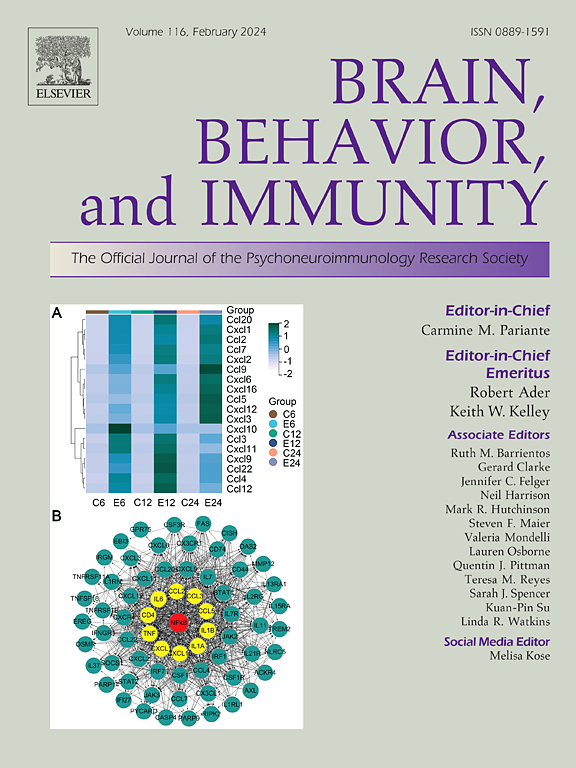Intravenous SARS-CoV-2 Spike protein induces neuroinflammation and alpha-Synuclein accumulation in brain regions relevant to Parkinson’s disease
IF 7.6
2区 医学
Q1 IMMUNOLOGY
引用次数: 0
Abstract
Background: Coronavirus disease 2019 (COVID-19) frequently presents with neurological symptoms in human patients and leads to long-lasting brain pathology in a hamster model. There is no overt SARS-CoV-2 virus replication in central neurons. Whether viral proteins are sufficient to cause this pathology requires further investigations. The SARS-CoV-2 Spike-protein S1-subunit (S1-protein) has recently gained interest for causing neuroinflammation and accelerating aggregation of alpha-Synuclein (aSyn) in vitro. Here, we show the impact of S1-protein in a broad spectrum of brain regions after injection via three different application routes in C57/BL6 mice. Methods: S1-protein was administered either intranasally, intravenously or intracerebrally. We quantified aSyn immunoreactivity and phosphorylated aSyn (pS129), microglia and astrocyte reactivity, ACE2/Neuropilin-1 receptor expression, and parvalbumin-positive interneurons in limbic system, basal ganglia, and cortical regions 14 days post-application. Plasma cytokine profiles were assessed 6 days post-injection. Results: While intracerebral injection resulted in decreased aSyn immunoreactivity with increased pS129 in males, intravenous injection led to increased levels of aSyn immunoreactivity and microglia cell density, predominantly in brain regions associated with Parkinson’s disease pathology. Intranasal application of S1-protein induced microgliosis in some brain regions but resulted in sex-dependent alterations of aSyn levels, with increases in females and decreases in males. All routes showed sex-dependent alterations in astrocytic reactivity, receptor expression, and parvalbumin-positive interneurons. Conclusion: Our results demonstrate that S1-protein itself leads to neuroinflammation, altered aSyn homeostasis, and disruption of inhibitory circuits in a route- and sex-dependent manner. These findings indicate the possibility of S1-protein being a crucial agent for both neuroinflammatory processes and altered protein regulation mechanisms. S1-protein trapped in tissue reservoirs could therefore explain symptoms occurring or persisting beyond viral clearance (Post COVID-19 condition).
静脉注射SARS-CoV-2刺突蛋白诱导帕金森病相关脑区神经炎症和α -突触核蛋白积累
背景:2019冠状病毒病(COVID-19)在人类患者中经常表现为神经系统症状,并在仓鼠模型中导致长期的脑部病理。在中枢神经元中没有明显的SARS-CoV-2病毒复制。病毒蛋白是否足以引起这种病理需要进一步的研究。最近,SARS-CoV-2刺突蛋白s1亚基(s1蛋白)在体外引起神经炎症和加速α -突触核蛋白(aSyn)聚集的研究引起了人们的兴趣。在这里,我们通过三种不同的应用途径在C57/BL6小鼠中展示了注射后s1蛋白在广谱脑区域的影响。方法:采用鼻内、静脉、脑内分别给药s1蛋白。我们量化了aSyn的免疫反应性和磷酸化aSyn (pS129),小胶质细胞和星形胶质细胞的反应性,ACE2/Neuropilin-1受体的表达,以及边缘系统、基底节区和皮质区的parvalbumin阳性中间神经元。注射后6 天评估血浆细胞因子谱。结果:脑内注射导致男性aSyn免疫反应性降低,pS129升高,而静脉注射导致aSyn免疫反应性水平和小胶质细胞密度升高,主要发生在与帕金森病病理相关的脑区。鼻内应用s1蛋白可在某些脑区诱导小胶质细胞增生,但导致aSyn水平的性别依赖性改变,女性增加,男性减少。所有途径在星形细胞反应性、受体表达和细小蛋白阳性中间神经元上均显示出性别依赖性改变。结论:我们的研究结果表明,s1蛋白本身以一种途径和性别依赖的方式导致神经炎症,改变异步稳态和抑制回路的破坏。这些发现表明s1蛋白可能是神经炎症过程和蛋白质调节机制改变的关键因素。因此,组织储存库中捕获的s1蛋白可以解释病毒清除后出现或持续的症状(COVID-19后状态)。
本文章由计算机程序翻译,如有差异,请以英文原文为准。
求助全文
约1分钟内获得全文
求助全文
来源期刊
CiteScore
29.60
自引率
2.00%
发文量
290
审稿时长
28 days
期刊介绍:
Established in 1987, Brain, Behavior, and Immunity proudly serves as the official journal of the Psychoneuroimmunology Research Society (PNIRS). This pioneering journal is dedicated to publishing peer-reviewed basic, experimental, and clinical studies that explore the intricate interactions among behavioral, neural, endocrine, and immune systems in both humans and animals.
As an international and interdisciplinary platform, Brain, Behavior, and Immunity focuses on original research spanning neuroscience, immunology, integrative physiology, behavioral biology, psychiatry, psychology, and clinical medicine. The journal is inclusive of research conducted at various levels, including molecular, cellular, social, and whole organism perspectives. With a commitment to efficiency, the journal facilitates online submission and review, ensuring timely publication of experimental results. Manuscripts typically undergo peer review and are returned to authors within 30 days of submission. It's worth noting that Brain, Behavior, and Immunity, published eight times a year, does not impose submission fees or page charges, fostering an open and accessible platform for scientific discourse.

 求助内容:
求助内容: 应助结果提醒方式:
应助结果提醒方式:


